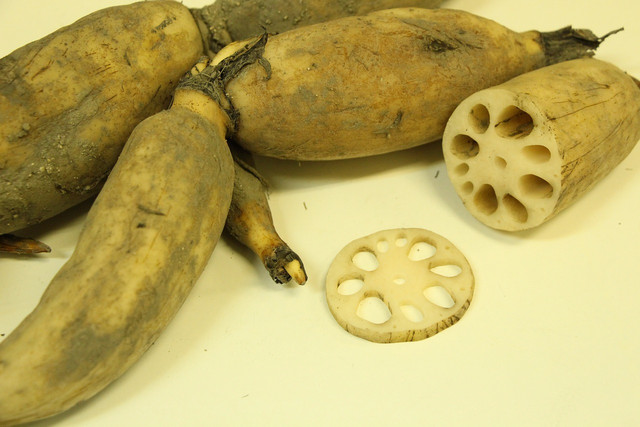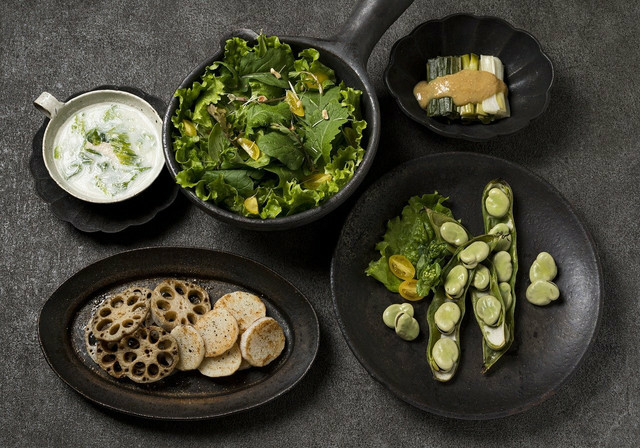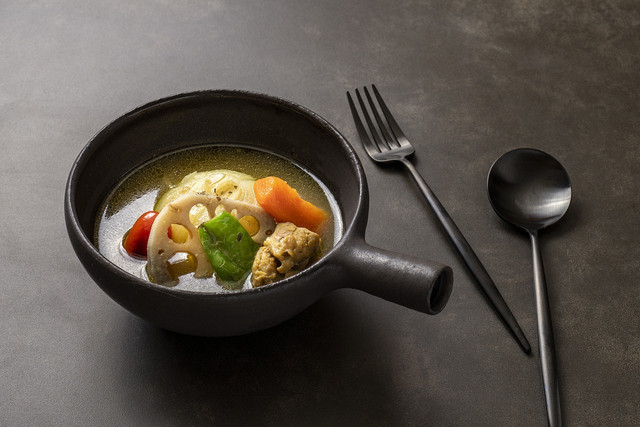You might not realize at first glance, but the beautiful lotus plant has many health benefits. Several portions of the plant are edible, but the lotus root benefits are perhaps the most accessible in everyday cooking.
The lotus plant, Nelumbo nucifera, is an aquatic plant native to Australia, New Guinea and parts of Asia and the Middle East. The flower can be pink, purple, or white. They grow in pools, lagoons and marshes. Because lotus flowers float in shallow and dirty waters, they are seen in many cultures as sacred symbols of enlightenment, energy and health.
What is referred to as the lotus root is actually part of the stem of the plant, called the rhizome. The rhizome found in the flower stem looks like a pale brown bulb. Once harvested, it can be peeled, cut up and eaten. The lotus root is a crispy, refreshing ingredient full of health benefits. Just one root contains no fat, almost six grams of fiber, and three grams of protein, at only eighty-five calories. It’s also packed with vitamins and minerals.
The lotus root can be eaten raw or added to your cooking. It is especially popular in Chinese, Japanese and Indonesian dishes. Change up your diet and get these five lotus root health benefits.
1. Antioxidants: Disease Prevention

Lotus root is chock-full of flavonoid and alkaloid compounds which act as antioxidants. These include gallic acid, catechin, epicatechin, chlorogenic acid, catechol and gallocatechin. When compared to other vegetables, lotus root has some of the highest antioxidant activity. This is a huge health benefit of lotus root as antioxidants are essential in neutralizing free radicals and reducing cellular oxidative stress which can damage cells and cause disease. Antioxidants can even help fight Alzheimer’s, cancer and liver damage.
2. High in Vitamins and Minerals



Lotus root is high in a variety of vitamins and minerals. Just one root contains thirty-three percent of your daily recommended copper, seven percent of your daily iron, and fourteen percent of needed potassium. The root is also high in thiamin, riboflavin, phosphorus, magnesium, manganese, Vitamin B6 and Vitamin C. These naturally occurring lotus root health benefits are easy to access simply by incorporating a bit of the root into your diet.
3. Fights Diabetes



Lotus root benefits individuals with diabetes in several ways. Firstly, lotus root can help lower blood sugar levels, perhaps due to its antioxidants. The root is also effective in breaking down food into sugar, and stimulating insulin secretion through the enzyme, nuciferin. Not to mention, lotus root is naturally anti-inflammatory, which further helps the body fight diabetes by preventing tissue damage.
4. Benefits Heart Health



The anti-inflammatory properties of lotus root benefit heart health as well, as they help prevent cardiovascular disease. The high rates of potassium and vitamin C further boost cardiovascular health as they are crucial to regulating blood pressure and preventing illness.
5. Natural Preservative



Lotus root is popular in the culinary world. Not only does it add great flavor and texture, it’s a natural preservative as well. The root is both anti-fungal and antibacterial, meaning it prevents the growth of fungus and wards off bacteria. Adding lotus root to your food can therefore help it stay fresh for longer periods. Of course, you should still refrigerate your leftovers!
Cooking Lotus Root



Lotus root is commonly enjoyed in soups, salads, curries and rice dishes. You can also snack on it raw. The lotus root is high in water content so it’s very refreshing and crunchy. Though it has little flavor on its own, it absorbs flavors from spices, broth and sauces easily.
There are a few ways to prepare lotus root. If you want to consume it raw, we recommend first placing the slices in a bath of vinegar and water for a few minutes. This will pickle the lotus root slightly, and take away some of the bitterness. Once removed, you can snack on the slices on their own, or add them to a salad, sandwich or vegetable plate.
Lotus root can be boiled and fried as well. The root can be easily added to dishes like vegan fried rice or a homemade vegan chop suey. Just make sure to toss the lotus root in toward the end, so it only cooks for a few minutes. The same goes for soups. Lotus root can be added into soups in the last five minutes for some extra texture. If cooked for too long, the lotus root can get sticky and starchy. You can also add raw slices of lotus root to garnish a soup or curry dish. This ingredient goes well with many Asian dishes, especially when paired with proteins such as homemade tempeh and seasoned tofu.
Read more:
- Benefits of Ginger: Uses, Health Effects and Recipes
- What is Miso Paste? Origin, Production and Nutrition
- Tofu Health Benefits: Behind the Protein Powerhouse
- Cinnamon Tea: 4 Health Benefits and How to Make Your Own
Do you like this post?






